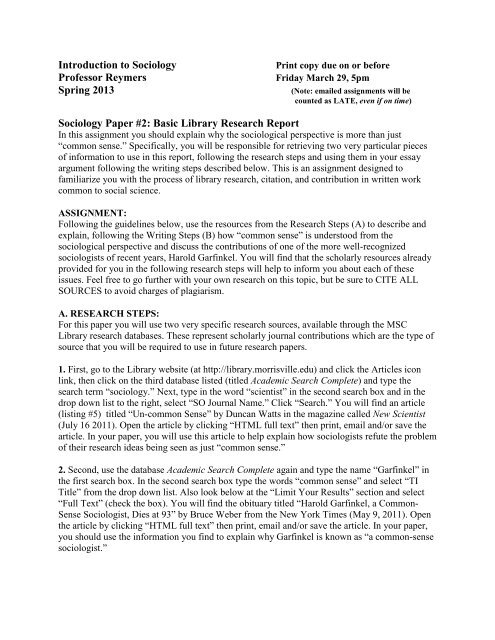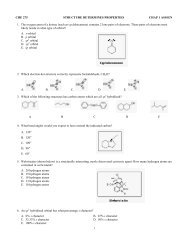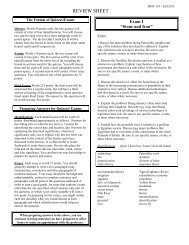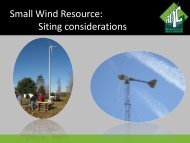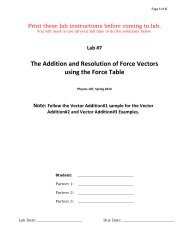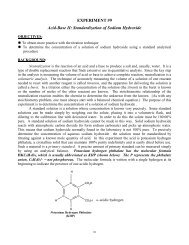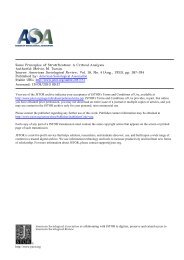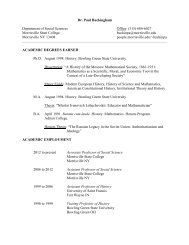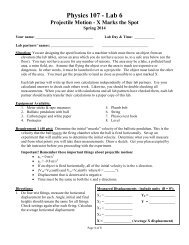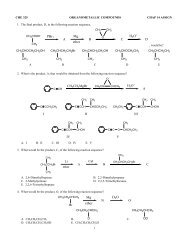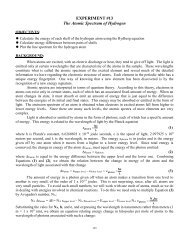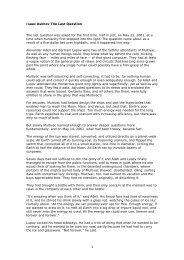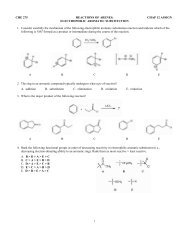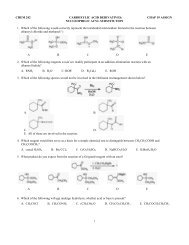Introduction to Sociology Professor Reymers Spring 2013 Sociology ...
Introduction to Sociology Professor Reymers Spring 2013 Sociology ...
Introduction to Sociology Professor Reymers Spring 2013 Sociology ...
Create successful ePaper yourself
Turn your PDF publications into a flip-book with our unique Google optimized e-Paper software.
<strong>Introduction</strong> <strong>to</strong> <strong>Sociology</strong><br />
<strong>Professor</strong> <strong>Reymers</strong><br />
<strong>Spring</strong> <strong>2013</strong><br />
Print copy due on or before<br />
Friday March 29, 5pm<br />
(Note: emailed assignments will be<br />
counted as LATE, even if on time)<br />
<strong>Sociology</strong> Paper #2: Basic Library Research Report<br />
In this assignment you should explain why the sociological perspective is more than just<br />
“common sense.” Specifically, you will be responsible for retrieving two very particular pieces<br />
of information <strong>to</strong> use in this report, following the research steps and using them in your essay<br />
argument following the writing steps described below. This is an assignment designed <strong>to</strong><br />
familiarize you with the process of library research, citation, and contribution in written work<br />
common <strong>to</strong> social science.<br />
ASSIGNMENT:<br />
Following the guidelines below, use the resources from the Research Steps (A) <strong>to</strong> describe and<br />
explain, following the Writing Steps (B) how “common sense” is unders<strong>to</strong>od from the<br />
sociological perspective and discuss the contributions of one of the more well-recognized<br />
sociologists of recent years, Harold Garfinkel. You will find that the scholarly resources already<br />
provided for you in the following research steps will help <strong>to</strong> inform you about each of these<br />
issues. Feel free <strong>to</strong> go further with your own research on this <strong>to</strong>pic, but be sure <strong>to</strong> CITE ALL<br />
SOURCES <strong>to</strong> avoid charges of plagiarism.<br />
A. RESEARCH STEPS:<br />
For this paper you will use two very specific research sources, available through the MSC<br />
Library research databases. These represent scholarly journal contributions which are the type of<br />
source that you will be required <strong>to</strong> use in future research papers.<br />
1. First, go <strong>to</strong> the Library website (at http://library.morrisville.edu) and click the Articles icon<br />
link, then click on the third database listed (titled Academic Search Complete) and type the<br />
search term “sociology.” Next, type in the word “scientist” in the second search box and in the<br />
drop down list <strong>to</strong> the right, select “SO Journal Name.” Click “Search.” You will find an article<br />
(listing #5) titled “Un-common Sense” by Duncan Watts in the magazine called New Scientist<br />
(July 16 2011). Open the article by clicking “HTML full text” then print, email and/or save the<br />
article. In your paper, you will use this article <strong>to</strong> help explain how sociologists refute the problem<br />
of their research ideas being seen as just “common sense.”<br />
2. Second, use the database Academic Search Complete again and type the name “Garfinkel” in<br />
the first search box. In the second search box type the words “common sense” and select “TI<br />
Title” from the drop down list. Also look below at the “Limit Your Results” section and select<br />
“Full Text” (check the box). You will find the obituary titled “Harold Garfinkel, a Common-<br />
Sense Sociologist, Dies at 93” by Bruce Weber from the New York Times (May 9, 2011). Open<br />
the article by clicking “HTML full text” then print, email and/or save the article. In your paper,<br />
you should use the information you find <strong>to</strong> explain why Garfinkel is known as “a common-sense<br />
sociologist.”
B. WRITING STEPS:<br />
1. OUTLINE: Write an outline showing how you are going <strong>to</strong> organize your essay (the question<br />
presupposes some type of organization). If you don’t know how <strong>to</strong> write an outline, see any<br />
number of excellent references on the web. Title your paper “Common Sense versus the<br />
Sociological Perspective”.<br />
2. THESIS: This paper should have a general theme (thesis) that sociologists see the world with<br />
a perspective that is different than just every day “common sense.” Your interpretation for this<br />
thesis should be discussed in light of the ideas presented in each research article. Integrate each<br />
of the sources you found above in<strong>to</strong> the body of your outline. Use Garfinkel as an example of a<br />
sociologist who has examined the idea of “common sense.” Give an example of how he has<br />
examined human behavior. Note in your outline where each source would be appropriate <strong>to</strong><br />
reference using a citation (see below). You can use the library database, the Microsoft Word<br />
program, or “Citation Machine” on the web (http://www.citationmachine.net/) <strong>to</strong> be sure you<br />
have an APA-style citation reference for each research source used in your paper.<br />
3. DRAFTS: Write a rough draft of your paper. Do not worry about spelling or grammar yet –<br />
just be sure that what you are writing makes some kind of sense (and is logically consistent). If<br />
you know that you are in particular need of grammar help, write more than one draft and have a<br />
friend, tu<strong>to</strong>r, or your professor (if he/she has time) look it over before finalizing it.<br />
4. CITATIONS: Collect your citations and make a References page. Refer <strong>to</strong> library documents<br />
regarding APA citation format <strong>to</strong> learn how <strong>to</strong> properly cite your researched material. (Note: the<br />
databases used above can provide a pre-formatted citation that you can cut and paste – provided<br />
you remember <strong>to</strong> save that information for when you are writing your References page). The<br />
References page containing the full citations for the two sources found in your research should<br />
appear at the bot<strong>to</strong>m of the second page of the paper.<br />
In-text (body) citation: If you directly quote the author of “Un-common Sense” <strong>to</strong> emphasize the<br />
idea in the article that “Common sense is exquisitely adapted <strong>to</strong> handling the kind of complexity<br />
that arises in everyday situations” (Watts 2011), you should cite the source right there in<br />
parentheses after the quote, noting the last name of the author of the article (Duncan Watts) and<br />
then noting that the article was published in 2011. That’s all the reference you need in the body.<br />
Reference page citation: Now, you must make sure that on the References section you have a<br />
complete citation <strong>to</strong> Duncan Watts’ article “Un-common Sense” from New Scientist magazine.<br />
Here’s an example of what it should look like:<br />
Watts, D. (2011). Un-common sense. New Scientist, 211(2821), 24-25. Retrieved from<br />
Academic Search Complete (EBSCOhost).<br />
5. FINALIZE: read the final paper aloud <strong>to</strong> yourself, and proofread/edit it again for grammar<br />
and spelling errors. No cover sheet is necessary, nor do I need your outline or research materials.<br />
Include your name, class and the date on the BACK of the paper. The paper should be 600-800<br />
words, typed, double-spaced, 1” margins, with a 10-12 point readable font. Email copies are not<br />
accepted; a 10-point penalty will be applied <strong>to</strong> any paper that is received only by email. You<br />
must get me a hard copy of the paper on or before the time due (Friday March 29 at 5pm) in<br />
order <strong>to</strong> receive full credit.


